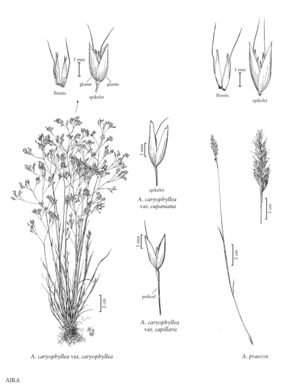Difference between revisions of "Aira praecox"
FNA>Volume Importer |
FNA>Volume Importer |
||
| Line 17: | Line 17: | ||
-->{{Treatment/Body | -->{{Treatment/Body | ||
|distribution=Md.;N.J.;N.C.;Mass.;Wash.;Va.;B.C.;N.S.;Del.;Oreg.;N.Y.;Pa.;Calif.;Conn. | |distribution=Md.;N.J.;N.C.;Mass.;Wash.;Va.;B.C.;N.S.;Del.;Oreg.;N.Y.;Pa.;Calif.;Conn. | ||
| − | |discussion=<p | + | |discussion=<p>Aira praecox is native to Europe. In the Flora region, it grows mainly along or near the Pacific and Atlantic coasts, in dry to vernally moist sand dunes or in sandy to rocky soils, on rock faces and ledges, and in disturbed areas such as the edges of roads, railways, and airports. It is usually found in lowland areas, though it occasionally grows at montane to subalpine elevations.</p> |
|tables= | |tables= | ||
|references= | |references= | ||
| Line 33: | Line 33: | ||
|basionyms= | |basionyms= | ||
|family=Poaceae | |family=Poaceae | ||
| + | |illustrator=Linda A. Vorobik and Hana Pazdírková | ||
|distribution=Md.;N.J.;N.C.;Mass.;Wash.;Va.;B.C.;N.S.;Del.;Oreg.;N.Y.;Pa.;Calif.;Conn. | |distribution=Md.;N.J.;N.C.;Mass.;Wash.;Va.;B.C.;N.S.;Del.;Oreg.;N.Y.;Pa.;Calif.;Conn. | ||
|reference=None | |reference=None | ||
| Line 38: | Line 39: | ||
|publication year= | |publication year= | ||
|special status= | |special status= | ||
| − | |source xml=https:// | + | |source xml=https://bibilujan@bitbucket.org/aafc-mbb/fna-data-curation.git/src/314eb390f968962f596ae85f506b4b3db8683b1b/coarse_grained_fna_xml/V24/V24_878.xml |
|subfamily=Poaceae subfam. Pooideae | |subfamily=Poaceae subfam. Pooideae | ||
|tribe=Poaceae tribe Poeae | |tribe=Poaceae tribe Poeae | ||
Revision as of 16:10, 30 October 2019
Plants annual; tufted. Culms 1-36 cm, erect. Sheaths usually scabridulous, occasionally smooth; ligules 1.4-5.3 mm, abaxial surfaces scabridulous, acute, becoming lacerate; blades (0.1) 0.25-5 cm long, 0.3-2.0 mm wide, antrorsely scabridulous, glabrous, prow-tipped. Panicles (0.5)1-4.1 cm long, 0.3-0.7 cm wide, sometimes reduced to a single spikelet in depauperate specimens; primary branches to 1.5 cm, appressed to the rachises, antrorsely scabridulous; pedicels 0.7-3.2 mm, enlarged at the apices. Spikelets 2.8-3.8 mm, green and purple-tinged; rachillas prolonged beyond the base of the distal floret. Glumes subequal, antrorsely scabridulous, especially on the midveins; lower glumes 2.8-3.6 mm, 1-3-veined; upper glumes 2.7-3.8 mm, 3-veined; callus hairs 0.3-0.5 mm; lower lemmas 2.4-3.3 mm, apices bifid, teeth 0.3-0.5 mm, awned, awns 3-4.5 mm; paleas 1.7-2.1 mm; upper lemmas similar; anthers 0.2-0.4 mm, yellow. Caryopses 1.3-1.7 mm long, 0.4-0.5 mm wide, glabrous, abaxial surfaces grooved 0.8-1 mm distally, adaxial surfaces grooved the entire length. 2n = 14.
Distribution
Md., N.J., N.C., Mass., Wash., Va., B.C., N.S., Del., Oreg., N.Y., Pa., Calif., Conn.
Discussion
Aira praecox is native to Europe. In the Flora region, it grows mainly along or near the Pacific and Atlantic coasts, in dry to vernally moist sand dunes or in sandy to rocky soils, on rock faces and ledges, and in disturbed areas such as the edges of roads, railways, and airports. It is usually found in lowland areas, though it occasionally grows at montane to subalpine elevations.
Selected References
None.
